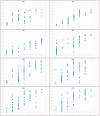A comparison of hierarchical cluster analysis and league table rankings as methods for analysis and presentation of district health system performance data in Uganda
- PMID: 26024882
- PMCID: PMC4748130
- DOI: 10.1093/heapol/czv045
A comparison of hierarchical cluster analysis and league table rankings as methods for analysis and presentation of district health system performance data in Uganda
Abstract
In 2003, the Uganda Ministry of Health introduced the district league table for district health system performance assessment. The league table presents district performance against a number of input, process and output indicators and a composite index to rank districts. This study explores the use of hierarchical cluster analysis for analysing and presenting district health systems performance data and compares this approach with the use of the league table in Uganda. Ministry of Health and district plans and reports, and published documents were used to provide information on the development and utilization of the Uganda district league table. Quantitative data were accessed from the Ministry of Health databases. Statistical analysis using SPSS version 20 and hierarchical cluster analysis, utilizing Wards' method was used. The hierarchical cluster analysis was conducted on the basis of seven clusters determined for each year from 2003 to 2010, ranging from a cluster of good through moderate-to-poor performers. The characteristics and membership of clusters varied from year to year and were determined by the identity and magnitude of performance of the individual variables. Criticisms of the league table include: perceived unfairness, as it did not take into consideration district peculiarities; and being oversummarized and not adequately informative. Clustering organizes the many data points into clusters of similar entities according to an agreed set of indicators and can provide the beginning point for identifying factors behind the observed performance of districts. Although league table ranking emphasize summation and external control, clustering has the potential to encourage a formative, learning approach. More research is required to shed more light on factors behind observed performance of the different clusters. Other countries especially low-income countries that share many similarities with Uganda can learn from these experiences.
Keywords: Decentralization; decision making; local government; low income; statistical analysis.
© The Author 2015. Published by Oxford University Press in association with The London School of Hygiene and Tropical Medicine.
Figures
Similar articles
-
A critique of the Uganda district league table using a normative health system performance assessment framework.BMC Health Serv Res. 2018 May 10;18(1):355. doi: 10.1186/s12913-018-3126-6. BMC Health Serv Res. 2018. PMID: 29747633 Free PMC article.
-
Decision-making in district health planning in Uganda: does use of district-specific evidence matter?Health Res Policy Syst. 2019 Jun 6;17(1):57. doi: 10.1186/s12961-019-0458-6. Health Res Policy Syst. 2019. PMID: 31170988 Free PMC article.
-
Bottleneck analysis at district level to illustrate gaps within the district health system in Uganda.Glob Health Action. 2017;10(1):1327256. doi: 10.1080/16549716.2017.1327256. Glob Health Action. 2017. PMID: 28581379 Free PMC article.
-
Comprehensive league table of cost-utility ratios: A systematic review of cost-effectiveness evidence for health policy decisions in India.Front Public Health. 2022 Oct 13;10:831254. doi: 10.3389/fpubh.2022.831254. eCollection 2022. Front Public Health. 2022. PMID: 36311623 Free PMC article.
-
Achieving universal health coverage in South Africa through a district health system approach: conflicting ideologies of health care provision.BMC Health Serv Res. 2016 Oct 7;16(1):558. doi: 10.1186/s12913-016-1797-4. BMC Health Serv Res. 2016. PMID: 27717353 Free PMC article. Review.
Cited by
-
Post-operative opioid pain management patterns for patients who receive hip surgery.Subst Abuse Treat Prev Policy. 2017 Mar 16;12(1):14. doi: 10.1186/s13011-017-0094-5. Subst Abuse Treat Prev Policy. 2017. PMID: 28298221 Free PMC article.
-
Beyond pilotitis: taking digital health interventions to the national level in China and Uganda.Global Health. 2017 Jul 31;13(1):49. doi: 10.1186/s12992-017-0275-z. Global Health. 2017. PMID: 28756767 Free PMC article. Review.
-
Transitioning health workers from PEPFAR contracts to the Uganda government payroll.Health Policy Plan. 2021 Oct 12;36(9):1397-1407. doi: 10.1093/heapol/czab077. Health Policy Plan. 2021. PMID: 34240177 Free PMC article.
-
QALY league table of Iran: a practical method for better resource allocation.Cost Eff Resour Alloc. 2021 Jan 13;19(1):3. doi: 10.1186/s12962-020-00256-2. Cost Eff Resour Alloc. 2021. PMID: 33441153 Free PMC article. Review.
-
Using health-facility data to assess subnational coverage of maternal and child health indicators, Kenya.Bull World Health Organ. 2017 Oct 1;95(10):683-694. doi: 10.2471/BLT.17.194399. Epub 2017 Aug 28. Bull World Health Organ. 2017. PMID: 29147041 Free PMC article.
References
-
- Andreopoulos B, An A, Wang X, Schroeder M. 2009. A roadmap of clustering algorithms: finding a match for a biomedial application. Briefings in Bioinformatics 10: 297–314. - PubMed
-
- Barron P, Day C, Loveday M, Monticelli F. 2005. The District Health Barometer Year 1, January–December 2004. Durban: South Africa Health Systems Trust.
-
- Beckstead JW. 2002. Using hierarchical cluster analysis in nursing research. Western Journal of Nursing Research 24: 307–19. - PubMed
-
- Berkhin P. 2006. A survey of clustering data mining techniques. In: Kogan J, Nicholas C, Teboulle M. (eds). Grouping Multidimensional Data. Berlin: Springer.
Publication types
MeSH terms
LinkOut - more resources
Full Text Sources
Other Literature Sources
Medical



